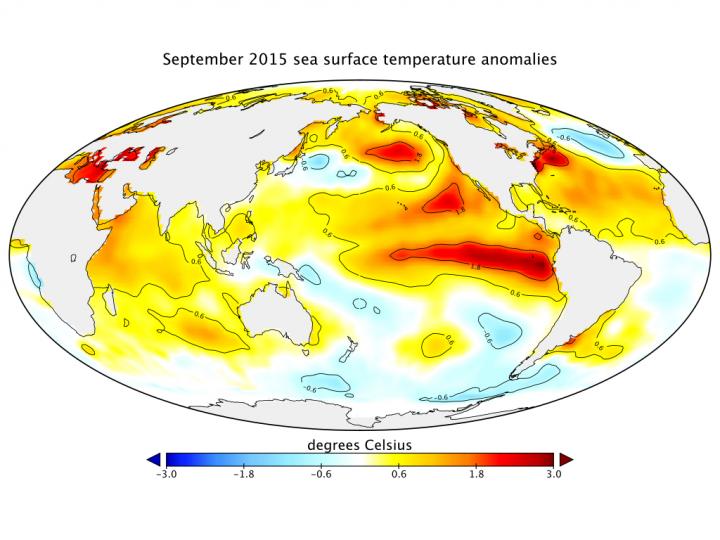New study explains near-annual Monsoon oscillations generated by El Niño

Sea surface temperature anomalies [degrees Celsius] of September 2015 from NOAA's Extended Reconstructed Sea Surface Temperature (ERSST) dataset. Credit: Smith et al., 2008: Improvements to NOAA's Historical Merged Land-Ocean Surface Temperature Analysis (1880-2006), J. Climate, 21, 2283-2296.
The results, published this week in the journal Proceedings of the National Academy of Sciences, show how the El Niño phenomenon interacts with the annual cycle of solar radiation in the western Pacific to generate a suite of new atmospheric pressure oscillations that affects wind and rainfall patterns in Southeast Asia, one of the densest populated areas on our planet.
There still remain major uncertainties about how the atmospheric circulation and the rainfall patterns over Southeast Asia and the Western Tropical Pacific respond to El Niño conditions, such as the current 2015 event.
The new findings by Malte Stuecker and Fei-Fei Jin, from the Department of Atmospheric Sciences, and Axel Timmermann from the International Pacific Research Center at the University of Hawai'i, Mānoa demonstrate that the atmospheric reaction is much more predictable than previously assumed.
As a result of the developing and decaying El Niño conditions and the seasonal march of the sun across the equator, a series of near-annual atmosphere oscillations is generated with periods of about 24, 16, 10, and 8 months, each with its own characteristic pressure pattern.
All of these contribute to the formation of an extended and very persistent high pressure system over the western tropical Pacific, which peaks in January and re-emerges in the boreal summer of the following La Niña year.
“Known as the Philippine Sea Anticyclone, this pattern plays a pivotal role in how the effects of El Niño are expressed in Southeast Asia,” explains Stuecker, climate scientist and lead author of the study. “In the past, many researchers looked at seasonal averages of wind and rainfall and missed the details of this variability,” he adds.
“Our new theory also explains the observed persistence of the Philippine Sea Anticyclone, even months after El Niño warming has subsided and well into the subsequent La Niña summer. The effect of El Niño in winter is qualitatively similar to the effect of La Niña in summer. These effects occur when the phases of Pacific warming and the annual solar cycle coincide,” says co-author Fei-Fei Jin, climate researcher and Professor at the Department of Atmospheric Sciences.
“These near-annual monsoon oscillations have some resemblance to the different ringing tones of a bell. Finding a new structure in the chaos of otherwise random weather variability has been very exciting, because it may open the door to enhanced seasonal predictability,” says co-author Axel Timmermann, Professor at the Oceanography Department and the International Pacific Research Center.
The scientists emphasize that this mechanism provides a fundamentally new way to understand variability in the atmosphere on a large range of timescales and can be applied to a number of different climate phenomena.
Media Contact
All latest news from the category: Earth Sciences
Earth Sciences (also referred to as Geosciences), which deals with basic issues surrounding our planet, plays a vital role in the area of energy and raw materials supply.
Earth Sciences comprises subjects such as geology, geography, geological informatics, paleontology, mineralogy, petrography, crystallography, geophysics, geodesy, glaciology, cartography, photogrammetry, meteorology and seismology, early-warning systems, earthquake research and polar research.
Newest articles

Bringing bio-inspired robots to life
Nebraska researcher Eric Markvicka gets NSF CAREER Award to pursue manufacture of novel materials for soft robotics and stretchable electronics. Engineers are increasingly eager to develop robots that mimic the…

Bella moths use poison to attract mates
Scientists are closer to finding out how. Pyrrolizidine alkaloids are as bitter and toxic as they are hard to pronounce. They’re produced by several different types of plants and are…

AI tool creates ‘synthetic’ images of cells
…for enhanced microscopy analysis. Observing individual cells through microscopes can reveal a range of important cell biological phenomena that frequently play a role in human diseases, but the process of…





















